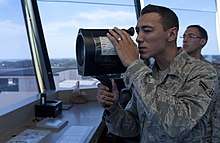Aviation light signals
In the case of a radio failure or aircraft not equipped with a radio, or in the case of a deaf pilot, air traffic control may use a signal lamp (called a "signal light gun" or "light gun" by the FAA[1][2]) to direct the aircraft. ICAO regulations require air traffic control towers to possess such signal lamps.[3][4] The signal lamp has a focused bright beam and is capable of emitting three different colours: red, white and green.[5][6] These colors may be flashed or steady, and have different meanings to aircraft in flight or on the ground.[5][2][7] Planes can acknowledge the instruction by rocking their wings, moving the ailerons if on the ground, or by flashing their landing or navigation lights during hours of darkness.[6][7] Air Traffic Control signal light guns are typically specified with a (white) center beam brightness of > 180,000 - 200,000 candela,[1][8][9] and are visible for roughly 4 miles in clear daylight conditions.[9][10][11] The table below describes the meaning of the signals.[5][2][7] The use of handheld combination red/green/white signal lamps for air traffic control dates back to at least the 1930s.[12]
| Signal | Aircraft in flight | Aircraft on the ground | Ground vehicles or personnel |
|---|---|---|---|
| Flashing white | ICAO – Land at this airport and proceed to apron (this is not a clearance to either land or taxi. Clearances to land and taxi will follow.) FAA – Not applicable |
Return to starting point on airport | Return to starting point on airport |
| Steady green | Cleared to land | Cleared for takeoff | Cleared to cross, proceed or go |
| Flashing green | Return for landing | Cleared to taxi | Not applicable |
| Steady red | Give way to other aircraft and continue circling | STOP | STOP |
| Flashing red | Airport unsafe, do not land | Taxi clear of the runway in use | Clear the taxiway/runway |
| Alternating red and green | Exercise extreme caution | Exercise extreme caution | Exercise extreme caution |

References
- Federal Aviation Administration (July 5, 1973). Gun, Signal Light, Portable, FAA-E-2214a Amendment-2. Department of Transportation. p. 5. Retrieved 12 May 2019.
- "TBL 4-3-1, Airport Traffic Control Tower Light Gun Signals". Section 3. Airport Operations. Federal Aviation Administration. Retrieved 12 May 2019.
- Aerodromes: Volume I Aerodrome Design and Operations (6th ed.). International Civil Aviation Organization. July 2013. p. 8-2.
- Civil Aviation Regulations (CAR 001 – Aerodrome Standards & Certification Regulations) 2018 (PDF). Kingdom of Bahrain Ministry of Transportation and Telecommunications. April 19, 2018. p. 68.
- Rules of the Air: Annex 2 to the Convention on International Civil Aviation (PDF) (10th ed.). International Civil Aviation Organization. July 2005. p. APP 1–3. Retrieved 12 May 2019.
- "4-3-13. Traffic Control Light Signals". Section 3. Airport Operations. Federal Aviation Administration. Retrieved 12 May 2019.
- "3. SIGNALS FOR AERODROME TRAFFIC". EUR-Lex. European Union. Retrieved 12 May 2019.
- Light, Airport Traffic Control, SDU-4/U, MIL-DTL-25971D. Department of Defense. February 18, 2015. p. 7. Retrieved 12 May 2019.
- MICC Fort Rucker. "58--Tower Signal Light Guns". USAOPPS. Retrieved 12 May 2019.
- "Signal Light Gun". ATI Avionics, Inc. Retrieved 12 May 2019.
- "LED Signal Light Gun". PPS Technical. Retrieved 12 May 2019.
- Harding, W (June 29, 1937). US Patent 2,085,020 Combination Sight and Indicator for Traffic Control Projectors. USPTO. Retrieved 13 May 2019.